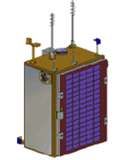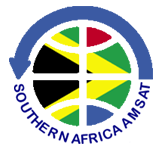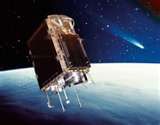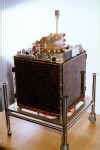 • After several delays, South Africa's second Amateur Radio satellite, SumbandilaSat, finally blasted to orbit aboard a Soyuz rocket from the Baikonur Cosmodrome in Kazakhstan on September 17 at 17:55:09 Central African Time (15:55 GMT)..
• After several delays, South Africa's second Amateur Radio satellite, SumbandilaSat, finally blasted to orbit aboard a Soyuz rocket from the Baikonur Cosmodrome in Kazakhstan on September 17 at 17:55:09 Central African Time (15:55 GMT)..
The launch of SumbandilaSat had to be postponed twice, once due to heavy winds and the second attempt due to the fuel pressure in the feed line which was four times too low and thus caused the fueling process to take too long to be completed in time for launch. The 81kg (about 200 pound) micro-satellite is about 1m x 0.5m in size. The name SumbandilaSat originates from the Venda language and means "lead the way". The satellite was released from the rocket while over the Antarctic and accessed by the ground station at the Stellenbosch University ten minutes later when the first command was sent to 'wake up' the satellites. Despite the low elevation orbit of less than 10 degrees SumbandilaSat responded well with its first telemetry.
The satellite was released from the rocket while over the Antarctic and accessed by the ground station at the Stellenbosch University ten minutes later when the first command was sent to 'wake up' the satellites. Despite the low elevation orbit of less than 10 degrees SumbandilaSat responded well with its first telemetry.
The main payload is a multi-spectral imager, but the satellite also carries an Amateur Radio component consisting of a 2 meter/70 cm FM repeater, parrot repeater (voice digipeater) and a voice beacon. This payload will find not only use by the amateur radio fraternity but also has a large educational outreach aspect of bringing space sciences into the class room. Earlier in September a team of SunSpace Engineers unpacked the satellite at the Baikonur launch facility in Kazakhstan and carried out a full systems test. All systems performed to specification. The amateur radio payload was tested from a little distance to check radio signal levels. All three systems performed flawlessly.
Earlier in September a team of SunSpace Engineers unpacked the satellite at the Baikonur launch facility in Kazakhstan and carried out a full systems test. All systems performed to specification. The amateur radio payload was tested from a little distance to check radio signal levels. All three systems performed flawlessly.
An intensive period of payload qualification will now follow during which each system will be tested. This is expected to take up to 3 months after which the command will shift to the CSIR's Satellite Application Centre at Hartebeeshoek, north of Pretoria.
After SumbandilaSat is fully commissioned, the repeater will be activated with an uplink at 145.880 MHz and a downlink at 435.350 MHz; there will also be a voice beacon at 435.300 MHz. The transponder mode will be controlled by a CTCSS tone on the uplink frequency. The CTCSS tone frequencies have yet to be announced. SumbandilaSat is sponsored by the Department of Science and Technology and built at SunSpace in cooperation with the Stellenbosch University. In addition to the SA-AMSAT amateur module, the satellite carries Stellenbosch University's radiation experiment and software defined radio (SDR) project, an experiment from Nelson Mandela Metropolitan University and a VLF radio module from the University of KwaZulu-Natal.
SumbandilaSat is sponsored by the Department of Science and Technology and built at SunSpace in cooperation with the Stellenbosch University. In addition to the SA-AMSAT amateur module, the satellite carries Stellenbosch University's radiation experiment and software defined radio (SDR) project, an experiment from Nelson Mandela Metropolitan University and a VLF radio module from the University of KwaZulu-Natal. South Africa’s initial entry into the space age was in early 1999 with the launch of SunSat-1 (OSCAR-35), a modest satellite built by postgraduate engineering students at the University of Stellenbosch. The satellite carried various experiments and an amateur radio transponder that delighted ham radio enthusiasts world-wide. SunSat was operational for almost two years, until February 2001. (Source: AMSAT-S.Africa, ARRL.)
South Africa’s initial entry into the space age was in early 1999 with the launch of SunSat-1 (OSCAR-35), a modest satellite built by postgraduate engineering students at the University of Stellenbosch. The satellite carried various experiments and an amateur radio transponder that delighted ham radio enthusiasts world-wide. SunSat was operational for almost two years, until February 2001. (Source: AMSAT-S.Africa, ARRL.)
PAIR SEES RARE FAIR MARE'S HAIR IN AIR!
-
This week, as Zach and I arrived in the parking lot at the Golden Phoenix
Chinese buffet in lovely Niskayuna, New York, I spied in the sky above a
curious ...
14 years ago

No comments:
Post a Comment